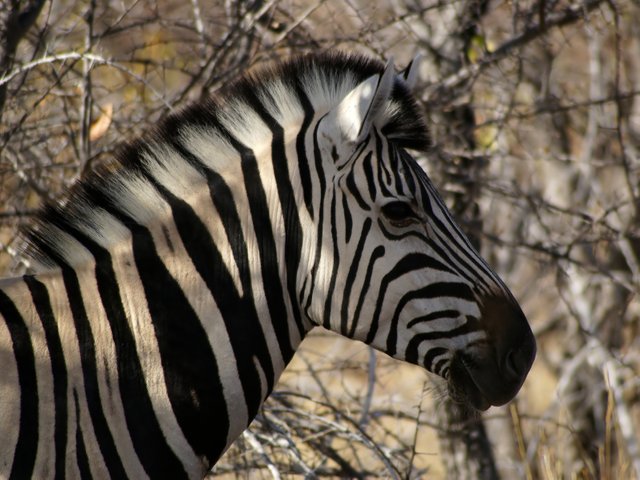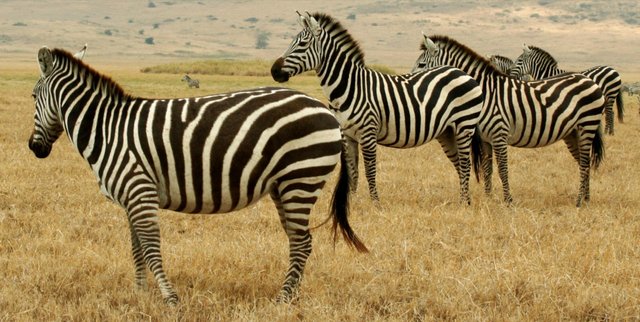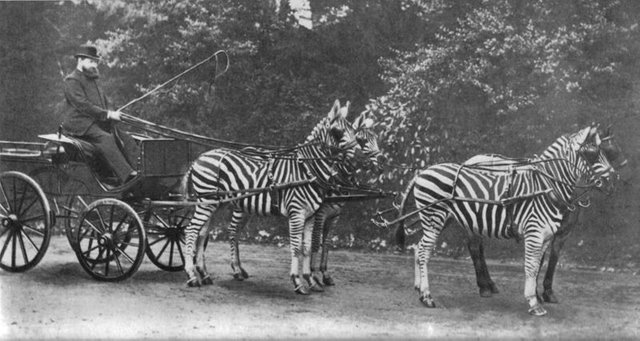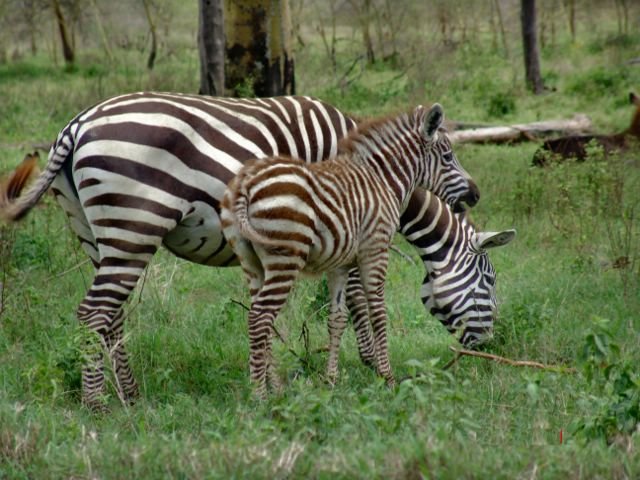THE ZEBRA: A LOOK AT THE HISTORY OF ANIMALS WITHOUT COLOR - PART II
Hello friends continuing with my publications regarding the animal label today I want to continue with part II of "A LOOK AT THE HISTORY OF ANIMALS WITHOUT COLOR", in this case today we will talk about the zebra a very important animal in history, which presents a great contrast for its various stripes as well as its evolution over time, I invite you to observe this interesting publication ..
Introduction
The word "zebra" does not represent an entity from the evolutionary point of view, but is an artificial grouping of three species that have in common the coloration with white and black stripes, which is not a derivative character, but primitive. The stripes also appear to a greater or lesser extent in the legs and backs of donkeys and wild horses, and are more pronounced in hybrids, as is the case with mules, showing that the presence of rays is an ancient character within the Equus genus, and not a derivative of a subgroup within it. Zebras, simply, have gone a step further in the development of stripes they already possessed, while horses and donkeys have tended to lose them or, at least, to mask them.

Image source:https://upload.wikimedia.org
Although the taxonomy of the zebras remains doubtful, certain studies, such as that of Debra K. Bennett (published under the expressive title "The stripes do not make the zebra"), indicate that the plain zebra and Grevy are sister species , but that the mountain zebra is more related to the horse than to these.In the current equidae, the traditional group formed by the African and Asian asses would be the only one with an evolutionary history behind it. The zebras are smaller than their relative the horse and very similar in appearance and in habits to the wild donkeys.
Zebras are one of the best-known animals in Africa, where they live in a variety of ecosystems, such as grass plains, savannas, forested regions or with shrubs, mountains and coastal hills. They are especially famous for their characteristic black and white stripes, which not only vary between species but also from one individual to the other, and for their erect crème. Unlike their closest relatives, horses and donkeys, zebras have never been truly domesticated.
With the exception of some common zebra populations that live in central Kenya, zebras live only in the southern half of the African continent. Although the regions of two different species may overlap, they do not cross because of the different number of chromosomes; Grevy's zebras are forty-six, common zebras forty-four and mountain zebras thirty-two.
Morphology
Although the black and white stripes presented by zebras is a common feature, the three species of zebra have no closer relationship with each other than they do with other animals of the genus Equus. In addition, the common feature of the stripes is not so definitive either; one of the subspecies of common zebra, the extinct quagga only had stripes on its neck. On the other hand, there are other perissodactyls that also have stripes on their legs.
Although they have a morphology similar to that of horses, they are smaller, with an average size of 2.3 meters in length, 1.2-1.5 meters high on the cross and weighing approximately 300 kilograms , even though Grévy's zebras can weigh up to 450 kilograms. In the latter species, males and females are similar in size, but in common zebras and mountain zebras males are slightly larger.
The zebras have a total of forty teeth: twelve incisors used to cut and tear off pieces of vegetation, four canines, twelve premolars and twelve molars, all used to grind the food before swallowing it.
The zebras have an excellent sense of sight. It is believed that they can see in color. Like many ungulates, zebras have eyes on the sides of the head, giving it a wide visual angle. Zebras also have night vision, although it is not as advanced as that of most of its predators, but its good hearing makes up for it.
Zebras have a great sense of hearing, and tend to have larger, rounder ears than horses. Like horses and other ungulates, zebras can turn their ears in almost any direction. In addition to good eyesight and hearing, zebras have a keen sense of taste and a sense of smell very sensitive to smoke, essential to survive fires.
The average life expectancy of the zebras is about thirty years, although they can live up to forty years in captivity. In a natural state, where predators represent a constant threat to these animals, the average longevity is approximately twelve years.
Evolution
For a long time it was believed that the first direct ancestor of the present equidae was Hyracotherium, a small perisodáctilo of the Eocene inferior and average of North America and Eurasia, but at the moment it has classified to him within the family of the paleotéridos, ancestors as much of the equidae as of the brontoterios, it was similar in size to the foxes (250-450 mm tall), with a relatively short head and neck and an arched back. He had forty-four teeth, with a dental formula typical of a mammal that feeds off the branches or top of the grass: three incisors, one canine, four premolars and three molars on each side of the maxilla. He used his teeth to grind the soft leaves and the fruits he fed on.
Image source :https://upload.wikimedia.org
When the climate changed and the forests opened at the beginning of the Oligocene, plains of grass and meadows began to appear, and in response to the change of environment, the equids also changed and developed more robust teeth, increased the size of their bodies and that of its legs, becoming faster animals. The North American genus Mesohippus walked on three fingers on each leg; He still had the first and the fifth fingers, but he did not use them to walk. The third finger was stronger and heavier than the others. Its long and slender legs allow to deduce that it was an agile and fast animal. One of the innovations of Mesohippus was that it had six posterior teeth, a feature that all subsequent equids would retain.
Reproduction
As in most animal species, females reach sexual maturity before males, and may have their first foal at the age of three. Males can not breed until they are five or six years old. Mares can give birth to a foal every twelve months, which is the length of gestation. They take care of the offspring for a maximum of one year. Like horses, zebras are able to stand, walk and nurse shortly after birth.At birth, a zebra foal is brown and white instead of black and white. Almost always a single colt is born, but on extremely rare occasions twins may be born.
In the case of mountain zebras and common zebras, the foals are protected by their mother, as well as by the male and other mares of the group. On the other hand, Grévy's zebra foals only have their mother as their usual protector, since, as mentioned above, the groups of this species usually disperse after a few months. The protection of the foals is especially relevant for these animals, since the offspring are an easy prey for the predators and half of them do not survive the first year of life despite the efforts of their mother and the male of the group. Another danger to foals is that they have observed infanticide and feticide among zebras, although this behavior has only been observed in specimens in captivity.
Behavior
Like most equidae, zebras are highly sociable. Even so, its social structure depends on the species. Mountain zebras and common zebras live in groups, known as "harems", which consist of a male with up to six mares and their foals. Non-dominant males either live alone or with other non-dominant males, until they are large enough to challenge a dominant male. When a group of zebras is attacked by hyenas or wild dogs, the mares are grouped with the foals in the middle while the male tries to scare away the attackers.
When a rival male tries to overthrow the dominant male, he challenges him by touching the opponent's nose with his or rubbing his back against his. This is a type of force demonstration designed to scare the opponent. If he does not give up, they start to fight, biting his neck and legs or, in extreme cases, kicking himself; These combats are more dangerous than most combats of this kind in the animal world, and a zebra can end up badly injured. The hierarchy of the group is reflected in the order in which its members walk; in front of everything, the oldest mare with her foals walks, then the other females come in order of age, also with their foals, and the male is the one who closes the group.

Image source :https://upload.wikimedia.org
Unlike the other zebra species, Grevy's zebras have no permanent social ties. Groups of this type of zebra rarely stay together for more than a few months. The young remain with their mother, while the adult males live alone. Even so, as in the other two species, non-dominant males are organized in groups. In cases of food shortages, many members of this species can congregate around a food source, giving the impression that they form a herd.
Food
Zebras are exclusively herbivorous mammals that eat mostly in the morning and in the afternoon, replenishing at noon. They are animals that feed on coarse grass, leaves and buds, and eat bark and branches. Their well-adapted digestive system allows them to subsist on a diet of lower nutritional quality than that needed by other herbivores, but it is also less efficient, forcing zebras to spend more than half the time eating.
Zebras can move about twenty kilometers in a day in search of food, but at the end of the day they usually return to their point of origin. Even so, the herds of zebras make a much more important annual migration, which coincides with the dry season and which many other African mammals also make and represent a movement of hundreds of thousands of animals at once.

Image source:https://upload.wikimedia.org
Attempts of domestication
Zebras have been tried as riding animals, because they are more resistant to African diseases than horses. Even so, most of these attempts failed, due to the more unpredictable nature of the zebras and their tendency to panic when they get nervous. For this reason, it is preferred to the cebroides (crosses between any species of zebra and a horse, pony, donkey or donkey) instead of pure zebras.
The fourth Mughal Emperor Jahangir (r. 1605-1627) commissioned a painting of zebras. In this painting, made by Ustad Mansur, the zebra is represented with stirrups. In England, the animal collector Lord Rothschild often used zebras to move his carriage. In 1907, Rosendo Ribeiro, the first doctor in Nairobi (Kenya), used a saddle zebra for home visits. In the mid-1800s, Governor George Gray imported zebras to New Zealand from his former South African jurisdiction, and used them to move his carriage to his private island, Kawau Island.

Image source: https://upload.wikimedia.org
Captain Horace Hayes, in "Points of the Horse" (circa 1899), compared the usefulness of different zebra species. Hayes put a chair and a bridle on a mountain zebra in less than an hour, but he did not manage to feed it the two days he had it. He remarked that the zebra's neck was so stiff and strong that it was not able to twist it in any direction. Even though he taught her how to do what she wanted on a circus track, when she pulled it out she was unable to control it. He found the common zebra easy to tame and considered it ideal to domesticate it, as it is also immune to the bite of the tsetse fly. He considered the quagga easy to tame because it was stronger, meek and more like horses than the other zebras.
In the chapter "9. Zebras and Unhappy Marriages" in his book "Weapons, germs and steel", J. Diamond also makes reference to the difficulty of domestication of the zebras:
Any species of mammal that is large enough is capable of killing a human being. However, some large animals have much more unpleasant dispositions and are more incurably dangerous than others.The four African zebra species are even worse. Attempts to domesticate went to the extreme of hooking them to cars: they were tested as draft animals in South Africa in the 19th century, the eccentric Lord Water Rothschild paraded through the streets of London in a carriage pulled by zebras. Unfortunately, zebras become terribly dangerous as they get older. [...] The zebra has the unpleasant habit of biting a person and not letting go. In the US, zebras injure more zookeepers every year than the tigers themselves. Zebras are also practically impossible to link with a rope -even for cowboys who win rodeo championships capturing with their bows to horses-, due to their ability to foolproof to observe the end of the rope flying towards them and then duck your head and dodge it. Hence, it has rarely (if ever) been possible to saddle or assemble a zebra, so the enthusiasm of the South Africans for their domestication disappeared.
Previous article:
THE WHITE TIGER - A LOOK AT THE HISTORY OF ANIMALS WITHOUT COLOR - PART I
Bibliography :
Jorge Hernández (January 9, 2.017). «What do zebras feed on?». Retrieved on February 15, 2017.
«Plains Zebra Equus burchelli.». Archived from the original on January 24, 2009. Retrieved on July 17, 2008.
Evidence of infanticide and feticide by males of common zebra in captivityGroves, C.P. & Bello, H.B. 2004. New investigations where the taxonomy of the zebras genus Equus, subgenus Hippotigris. Mammalian Biology, 69: 182-196.
«Hyracotherium». Florida Museum of Natural History. Retrieved on July 12, 2008.Hunt, Kathleen (1995). Horse Evolution. TalkOrigins Archive.
«Cenozoic Palaeos: Oligocene». Palaeos Archived from the original on June 16, 2008. Retrieved on July 13, 2008.https://www.nationalgeographic.com/animals/mammals/p/plains-zebra/
